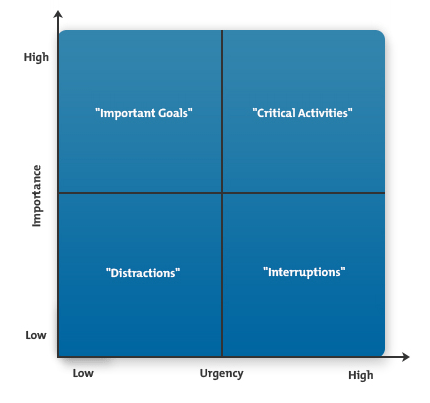 You are if your modus operandi is fire fighter.
You are if your modus operandi is fire fighter.
Because, let’s be real, you’re mostly putting out fires set by other people.
It may make you feel like a hero, but it’s not the best way to approach your job on a daily basis. Let me explain by asking you to answer these questions:
- Do you find yourself spending most of your time responding to other people’s crises?
- Is your day consumed with disruptive activities?
- Do you answer email all day long?
- Do you immediately respond to texts and voicemail?
- Are you constantly reacting, with little time left for acting?
If so, you (and most likely your co-workers too) are probably not doing the important preventive work that must be done so these urgent fires don’t break out.
Prevent vs. Fight
Anyone can fight a fire; “Only YOU can prevent [forest] fires.”
So, get out of the trees for a minute, take a perch at the top of a hill, and get a panoramic birds-eye view of your organization’s forest. Look for the places where danger lurks and fires might break out. For example (this is a non-exclusive list), it could be the way:
- You’ve mis-organized your database input fields and/or report extractions.
- You’ve neglected to invest in a robust donor database and/or email service provider.
- You’ve confusingly set up your website menu navigation.
- You’ve bewilderingly set up your donation button and landing pages.
- Your email subscription box is not mobile responsive.
- You’ve failed to schedule regular e-news publication dates.
- You’ve forgotten to schedule your appeal mailing far enough in advance.
- You’ve only scheduled one or two emails a year.
- You don’t have an automated email welcome series for new donors.
- You don’t have a written donor love and loyalty policy to retain current supporters.
- You don’t have a written donor acknowledgement policy.
- You don’t have a written gift acceptance policy.
- You’ve neglected to message potential business sponsors during their fiscal years.
- You’ve neglected your social media platforms for many months.
- You have outdated information on your website.
- You’re not segmenting your mailings based on donor affiliation, interest and identity.
- Your staff are working in siloes, rather than within an organization-wide culture of philanthropy.
This list can go on, and no doubt you’ve thought of a few places where fire hazards lurk. There is a way around this. But first you must fully embrace the notion that firefighting is not your job.
Important vs. Urgent
Your job is to address the important activities that will enable you to achieve your goals. Firefighters are only needed when you/everyone is neglecting the important activities of preventing fires. That’s when you switch to urgent mode, engaging in activities often associated with someone else’s goals. Even if you’re a boss, and think it’s your job to help staff accomplish their goals, you undoubtedly still have your own agenda to accomplish.
Consider this: Maybe part of your agenda is putting in place the staffing, systems, procedures, and training that will help your staff avoid fires?
Getting the right job done requires prioritizing and time management. In “The Seven Habits of Highly Effective People,” Stephen Covey distinguishes again and again between the urgent and the important, noting that focusing on the former makes you dependent (your work is reactive) while the latter gives you independence (you can take initiative that propels you toward your own goals). The urgent disrupts; the important erupts.
5 Action Tips to Erupt, not Disrupt
1. Use an Urgent/Important Matrix
Begin by making a list of all the things you do on a daily or weekly basis. Now use the matrix below to plot these tasks into a graphic format. This tool, credited both to President Dwight Eisenhower and Steven Covey, is super-useful, especially if you’re a visual person. You may suddenly notice a lot of so-called “urgent” items with relatively low importance when it comes to reaching your outcome-focused objectives (e.g., answering emails; daily meetings, etc.). These are called “interruptions,” and should really be relegated to a lower spot on your to-do list.

2. Put First Things First
Every day, begin with the end in mind. What do you really need to get done to move your agenda forward? Look carefully at what you’ve graphed into the High/Important box. Sometimes the High/Critical may supersede these (e.g., an earthquake, flood, fire or pandemic will push the urgent to the forefront), but generally you want to dedicate precious, limited resources to what’s in this upper left-hand corner. Prioritize, plan and execute your daily/weekly tasks based on what’s important rather than what’s urgent. Ask yourself: Will working on this today get me towards my goals?
3. Block Time on Your Calendar
When you have an important project to accomplish, make some inviolate time. Treat it like a doctor’s appointment, where you’ll get charged if you miss it. [And, trust me, you’ll pay a cost if you persevere in frittering around the edges of more effective, to-the-point strategies.] Don’t look at your email or cell phone during this period. If you must, get out of the office and go someplace else where you won’t be distracted. Trust me; in the few hours you’re ‘disconnected’ the world won’t come to an end.
4. Take Responsibility for Your Choices.
If you choose to react, you’re not going to get where you want to go. Embrace the fact your decisions determine how effective you’ll be in accomplishing your goals. It’s your choice. If you choose to work on somebody else’s problem, it’s not their fault. Guess who will be blamed if you don’t get your job done?
5. Delegate Urgent Items
Keep your priorities in mind whenever the “urgent” rears its ugly head. Don’t fall back on the tendency to think either (a) “This is a quick fix” (as a general rule, there’s no such thing), or (b) “I can do this faster/better than anyone else” (this may be true, but you can also do your priority task faster/better than anyone else – and it’s more important).
6. Plan Ahead to Avoid the Urgent.
A lot of urgent things happen because we leave important things to the last minute. Anyone who’s ever pulled an ‘all-nighter’ knows this. Some things, of course, cannot be foreseen. But a lot can, and should, be anticipated. Build timelines into all your projects, working from the due date backwards. Don’t just guess at these. For example, if you’re planning a direct mail appeal, call the designer, printer, photographer and mail house to find out how long their turn-around is. Call the post office to ascertain how long mailings are taking during the period you plan to mail. Ask your database coordinator how long it will take to pull segmentation reports. And so forth.
7. Ask Key Questions Before Favoring Urgent over Important
Firefighting, sadly, is a lot easier than fire preventing. It takes comparatively little thought to just react. You just get into “action mode” and can be really busy. Busy resembles productive. And you feel like a hero. But, when you really stop to ponder the matter, wouldn’t it be better if you allowed the important, planful, preventive work to erupt from the constraints you’ve placed on them so those fires never occurred? Ask yourself:
-
- Must this be done NOW?
- If not, when can I schedule to get it done so it becomes part of my thoughtful, well-considered plan and an important ‘to-do’?
- If so, do I need to be the one to do this? To whom can I delegate?
- What do I have to put on my ‘to-do’ list for the future so this doesn’t happen again?
Closing Thoughts
Prioritize your own problems, allowing the important to productively erupt. Erupting volcanoes build mountains. What’s your mountain? Own it. Build it. Don’t get distracted by the fires.
Give your important tasks the time and space they deserve. Don’t hold them back by spending all your time responding to interruptions.
Interrupting fires, even when you fight them, burn down forests. It’s a never-ending cycle; a battle with no productive end.
If you were to commit today to doing one thing differently so you can change your focus from the urgent to the important, what would it be?
Want to Work More Effectively All the Time?
 Working smart means taking time to develop the necessary mindset, and supporting infrastructure, to assure you’re on the path to success. Do you have clarity on what you hope to accomplish? Are there pre-conditions to success not in place? Are key players on the same page? Do you show donors what’s in it for them to affiliate with you? What value do you offer? Why is it better than what anyone else is offering?
Working smart means taking time to develop the necessary mindset, and supporting infrastructure, to assure you’re on the path to success. Do you have clarity on what you hope to accomplish? Are there pre-conditions to success not in place? Are key players on the same page? Do you show donors what’s in it for them to affiliate with you? What value do you offer? Why is it better than what anyone else is offering?
These questions and more are addressed in The 7 Clairification Keys To Unlock Your Nonprofit’s Fundraising Potential. Through a series of clairifying worksheets and individual + group exercises, this 42-page guide will give you fresh insights so you can think strategically about your plan to achieve desired outcomes. Stop mindlessly tweaking last year’s plan, and dig deep into why you’re doing these things. Clairify your (1) values; (2) stories; (3) brand; (4) social channels; (5) support constituencies; (6) engagement objectives, and (7) resources + systems.
All Clairification products come with a no-questions-asked 30-day 100% refund guarantee. If you’re not happy,
Photo by Montsera on Pexels.





